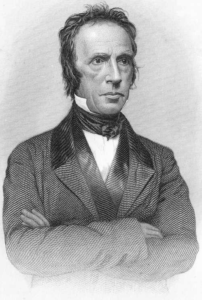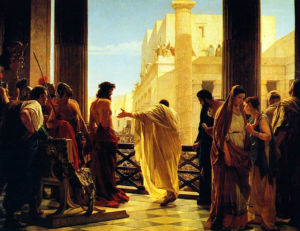The Calling of Saint Peter and Saint Andrew by Luca Giordano (1632–1705)
In today’s Christian culture, the word rabbi is mainly foreign. Not surprisingly, then, the original context of discipleship to a rabbi has largely been forgotten. We may better understand Jesus and his teachings when viewed in the light of him being a rabbi. It is of the utmost importance to examine the definition of a first century rabbi and Jesus’ function in order to understand his teachings and expectations then and now.This is a three-part series on Jesus the Forgotten Rabbi. In Part 1: A Rabbi in Jesus’ Day we will look at what a rabbi was in the context of Jesus’ day. In Part 2: Was Jesus a Rabbi? we will examine Jesus’ validity and function as a rabbi. And in Part 3: Discipleship to Rabbi Jesus Today we will discuss the significant application for modern day Christians.
A Rabbi in Jesus’ Day
The sun shined brightly as brothers Andrew and Simon threw out their nets and pulled them in again. They had been fishing all morning. Suddenly, a man walked up to them on the shore and called out, “Come follow me, and I will make you fishers of men.” Andrew and Simon looked at each other and with cautious excitement threw down their fishing nets. They left everything and entered into a master-disciple relationship with Jesus of Nazareth.
In calling and taking disciples after him, Jesus adopted a methodology popular with rabbis of first century Jewish religious tradition. At that time in Israel, Jesus was not doing something new or yet unseen by calling disciples after him to be with him in an itinerant preaching and teaching ministry.1Rabbis were famous for taking disciples after them in order to teach and raise them up.2
The disciple was purposely to follow the teacher with the sole intent of learning everything the teacher had to teach, so he could adopt the same beliefs and put the teachings into practice as his lifestyle in becoming like the teacher.
The word translated as “disciple” comes from the Greek word mathetes. The definition of mathetes is literally “a learner”; it is “from a root math—, indicating thought accompanied by endeavor.”3
In the Jewish culture and religion of Jesus’ day, the master-disciple teaching methodology was well established. Discipleship was the cultural vernacular for how rabbis trained religious leaders and teachers.
While it cannot be disputed that the primary purpose of Jesus’ incarnation was to be the atoning sacrifice for the sins of mankind, neither can it be disputed that part of his messianic mission was to teach the will and way of God.
The term rabbi is from the Hebrew word that means “lord” or “master.”4It also means “my lord,” or “my great one,” though the Hebrew pronominal suffix “î” (meaning “my”) gradually lost its possessive meaning.5It is a form of address and thus an honorary title for outstanding teachers of the law in a biblical context.6 Rabbi expressed “the spontaneous respect given to one who was especially knowledgeable of the Jewish religion and exemplary in its practice.”7Master, sir, and rabbi are synonymous usages.8The similar term “rabboni” as recorded in Mark 10:51 and John 20:16 is a heightened form of rabbi.
The root of rabbi is rab and means “many” or “great.”9 Old Testament usage shows rab as a term of respect for an officer, captain, or chief by those under his authority (Jer 39:13; Dan 1:3; Jon 1:6).10It also comes down through the titles of certain Assyrian and Babylonian officials (2 Kings 18:17; Jer 39:18).11
The New Testament text gives insight into understanding the meaning of rabbi. The gospels in particular “in a variety of contexts…use “Rabbi” as an esteemed form of address rather than an official title.”12 John defines the address of rabbi as teacher: “And Jesus turned and saw them following, and said to them, ‘What do you seek?’ They said to Him, ‘Rabbi (which translated means Teacher), where are You staying?’” (John 1:38). Again, after Jesus’ resurrection, John reports: “Jesus said to her, ‘Mary!’ She turned and said to Him in Hebrew, ‘Rabboni!’ (which means, Teacher)” (John 20:16). Matthew shows that Jesus defined rabbi as teacher when speaking of the Pharisees: “They love the place of honor at banquets and the chief seats in the synagogues, and respectful greetings in the market places, and being called Rabbi by men. But do not be called Rabbi; for One is your Teacher, and you are all brothers” (Matt 23:6-8). The title and word “Teacher” (didaskolos in the Greek New Testament) is intended as a translation of Rabbi.13
That John takes time to interpret “Rabbi” and “Rabboni” for his readers as “Teacher” indicates that the intended readers were probably unfamiliar with Jewish or Hebrew/Aramaic terminology and needed guidance from an interpreter.14 John’s interpretation is also a likely result and evidence of the “de-Judaization of the gospel” that set in before the completion of the New Testament;15 Greek-speaking believers did not necessarily understand the context of Jewish belief and practice. John does not assume that his immediate listeners understand that a rabbi is a teacher. Where John directly interprets, Matthew infers. Thus, Rabbi and Teacher are synonymous in a New Testament context.
One last point—the term rabbi in the first century does not carry with it the same meaning as in the twenty-first century. The term took on additional meaning after the destruction of the temple in Jerusalem in 70 A.D. There is some controversy over whether rabbinic Judaism formed at all before the destruction of the temple, which would be well after Jesus’ death.16
Regardless, the use of “‘Rabbi’ developed from a popular term of honor into a more formal title. After the NT era it was used of one officially recognized as an authoritative teacher and judge in the realm of Jewish law.”17 The later conditions for bearing the title rabbi, namely study and ordination, were not yet binding in the time of Jesus.18 In the Jewish mind, the rabbi would come to serve as the new priest, with the temple being destroyed and not rebuilt.19 In the twenty-first century a rabbi functions more like a Christian pastor who goes through a period of advanced formal education and is ultimately ordained into ministry.
Go to Part 2: Was Jesus a Rabbi?
References
| ↑1 | David Bivin, New Light on the Difficult Words of Jesus: Insights from his Jewish Context (Holland, MI: En-Gedi Resource Center, 2007), 11-15. |
|---|---|
| ↑2 | Lois Tverberg and Bruce Okkema, Listening to the Language of the Bible: Hearing it through Jesus’ Ears (Holland, MI: En-Gedi Resource Center, 2006), 125-26. |
| ↑3 | W. E. Vine, Vine’s Expository Dictionary of New Testament Words (Iowa Falls: Riverside, n.d.), 318. |
| ↑4 | Walter Bauer, Frederick W. Danker, William F. Arndt, and F. Wilbur Gingrich, A Greek-English Lexicon of the New Testament and Other Early Christian Literature, 3rd ed. (Chicago: University of Chicago Press, 2000), 902. |
| ↑5 | Marvin R. Wilson, “Rabbi,” in The International Standard Bible Encyclopedia, ed. Geoffrey W. Bromiley, vol. 9 (Grand Rapids: Eerdmans, 1979), 30. |
| ↑6 | Walter Bauer, Frederick W. Danker, William F. Arndt, and F. Wilbur Gingrich, A Greek-English Lexicon of the New Testament and Other Early Christian Literature, 902. |
| ↑7 | William E. Phipps, The Wisdom and Wit of Rabbi Jesus (Louisville: John Knox Press, 1993), 57. |
| ↑8 | Walter Bauer, Frederick W. Danker, William F. Arndt, and F. Wilbur Gingrich, A Greek-English Lexicon of the New Testament and Other Early Christian Literature, 902. |
| ↑9 | Henry Lopold Ellison, “Rabbi,” in The New International Dictionary of New Testament Theology, ed. Colin Brown, vol. 3, (Grand Rapids: Zondervan, 1986), 115. |
| ↑10 | Marvin R. Wilson, “Rabbi,” in The International Standard Bible Encyclopedia, ed. Geoffrey W. Bromiley, vol. 9 (Grand Rapids: Eerdmans, 1979), 30. |
| ↑11 | Henry Lopold Ellison, “Rabbi,” in The New International Dictionary of New Testament Theology, vol. 3, 115. |
| ↑12 | Marvin R. Wilson, “Rabbi,” in The International Standard Bible Encyclopedia, vol. 9, 30. |
| ↑13 | Jaroslav Pelikan, Jesus through the Centuries: His Place in the History of Culture (New Haven: Yale University Press, 1985), 11. |
| ↑14 | Gerald L. Borchert, “John,” in Mercer Commentary on the New Testament, ed. Watson E. Mills and Richard F. Wilson (Macon: Mercer University Press, 2003), 1049. |
| ↑15 | William E. Phipps, The Wisdom and Wit of Rabbi Jesus, 57. |
| ↑16 | For a treatment of Rabbinic Judaism being a reform movement that developed after the destruction of the Jerusalem temple taking shape only in the first centuries, see Gabriele Boccaccini, Roots of Rabbinic Judaism, Grand Rapids: Eerdmans, 2002. |
| ↑17 | Marvin R. Wilson, “Rabbi,” in The International Standard Bible Encyclopedia, vol. 9, 30. |
| ↑18 | Klaus Wegenast, “Teach,” in The New International Dictionary of New Testament Theology, vol. 3, 767. |
| ↑19 | Jacob Neusner, “Introduction,” in Understanding Rabbinic Judaism: From Talmudic to Modern Times, ed. Jacob Neusner, (Eugene: Wipf and Stock, 2003), 13. |



